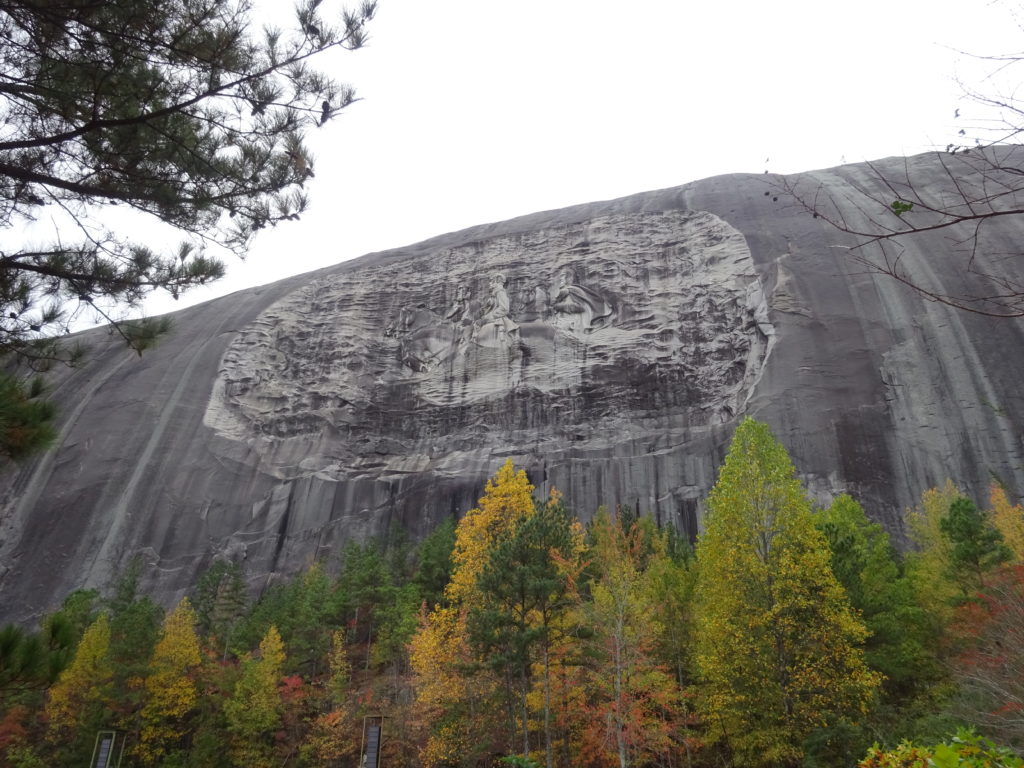
As I wrote about earlier, during this summer of political correctness run amok, the beautiful Confederate carving at Stone Mountain has become a target of anti-Confederate intolerance. Now, a group of politically-correct, intolerant people have formed an organization called the Stone Mountain Action Coalition and have presented their demands to the Stone Mountain Memorial Association, the group in charge of maintaining the mountain and its surrounding park.
For those who have never seen Stone Mountain, it is a huge mountain near Atlanta, Georgia with an enormous image of Jefferson Davis, Robert E. Lee, and Stonewall Jackson carved into the side for all to see. Near the base of the mountain are various statues, flags, and plaques honoring people from each of the 13 states of the Confederacy. Stone Mountain is, in my opinion, a truly unique, amazing, and awe-inspiring sight.
According to the Atlanta Journal-Constitution, the Stone Mountain Action Coalition is demanding that the carving no longer be maintained, that the nearby Confederate flags be removed, that Confederate-related names of streets and buildings in the park be replaced, and that the park focus on themes such as “nature, racial reconciliation and justice.”
One of the co-chairs of the coalition, Ryan Gravel, said, “We don’t believe that taking a piecemeal, token kind of approach to adding little trinkets here and there is going to be good enough to really resolve the history of the mountain and the way that people see it.” Meymoona Freeman, another co-chair, said, “It’s time for transformation, it’s time for healing, and it’s time for progress.” Other members of the coalition stressed the need to make the park “more welcoming.”
But what exactly needs to be “resolved” about Stone Mountain? The carving is an incredible feat of engineering and art honoring three historical leaders. The fact that some people dislike those historical leaders, and by extension the carving, is not a problem that needs to be solved. Every single thing in the world has people who like it and people who do not like it. No one has the right to demand that everything they do not like be obliterated from the world, particularly when the thing in question is a unique, magnificent, and beautiful landmark that took years of creativity, craftsmanship, and hard work to create. There is nothing hateful or racist about honoring the Confederacy and its leaders. As the Confederate point of view falls further out of favor among the mainstream media, political establishment, and society as a whole, it is even more important that sites like Stone Mountain be preserved. Even if the carving is not actually removed, to cease maintaining it and to get rid of the Confederate flags and street names would be to strip the park of its uniqueness and identity. It would be to make Stone Mountain, and the world, a more bland, homogenous, and character-less place. For those who admire the Confederacy and enjoy this memorial park, getting rid of the Confederate features would be the exact opposite of healing, the exact opposite of progress, and the exact opposite of making the park more welcoming. And to actually destroy the carving would be so unfathomably awful that it hurts to even consider the possibility. (The Atlanta Journal-Constitution asked several geologists for their thoughts on how such a thing could be achieved. Their ideas, which involve explosives, disfigurement, years of dangerous work, and millions of dollars, are sickening when one considers that these measures would be employed with the goal of destroying a priceless work of art.)
The reason the Stone Mountain Action Coalition is not demanding removal outright is that Georgia law currently protects the Confederate memorial carving. This law was enacted as part of a compromise in 2001 when the state legislature voted to remove the Confederate flag from the Georgia state flag. The law reads: “The memorial to the heroes of the Confederate States of America graven upon the face of Stone Mountain shall never be altered, removed, concealed, or obscured in any fashion and shall be preserved and protected for all time as a tribute to the bravery and heroism of the citizens of this state who suffered and died in their cause.” The fact that some people are even mentioning the possibility of changing this law demonstrates the intolerance of the politically-correct crowd. What part of “preserved and protected for all time” do they not understand? First, Georgia’s flag was changed, with the assurance that Stone Mountain would remain. Less than 20 years later, those who seek to destroy Confederate history have broken their promise and are trying to get rid of Stone Mountain as well. Attempts at compromise have done nothing to stop the inexorable progression towards a complete erasure of Confederate heritage. There can be no compromise, there can be no moderation, and there can be no “pushing the limits” of the law by ceasing maintenance of the carving and hoping that nature and the elements gradually erode it. Stone Mountain must be preserved and protected for all time, just as the law says. And given that the anti-Confederate bullies have reneged on their part of the compromise, advocating for a return of the old state flag wouldn’t hurt either.




